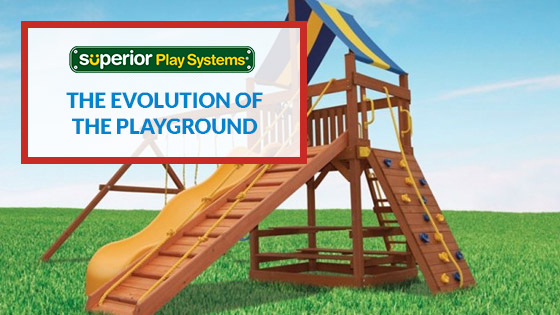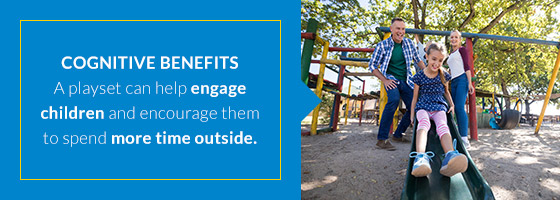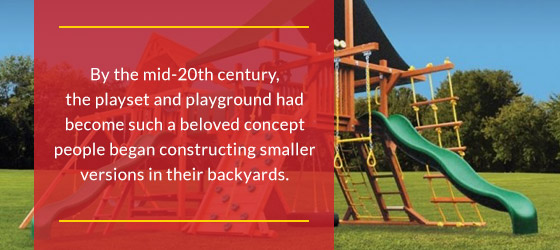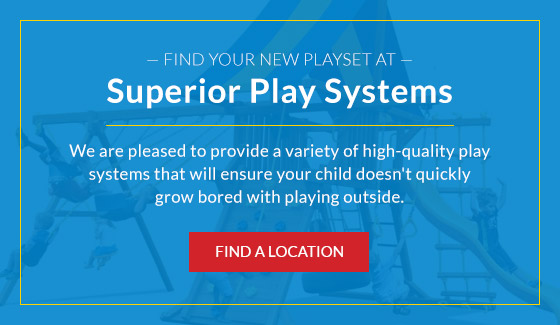
The Evolution of the Playground
- The Importance of Backyard Play
- The History of the Playset
- Continue the Tradition With Superior Play
At some point or another, everyone has played on a playset. Whether it was in your backyard or at the park down the street, everyone has at least one fond memory of flying high on the swings, racing across a set of monkey bars or careening down a slide. If you’re reading this, odds are you’ve grown from the child on the swings and slide to the parent standing behind the swings or squatting at the bottom of the slide. When you go to the playground, you’re watching your child build the same kinds of memories you did. But, did you know playsets — both the backyard and public varieties — are about more than creating fun childhood memories?
That’s right. Their existence dates back well more than 100 years, but over the last century, playgrounds have become increasingly important to help children learn about their world, their friends and, perhaps most importantly, themselves. They have grown from a novelty of city tenements to an accepted part of the landscape. In fact, commercial playground structures and their equipment have become such a part of our culture we often don’t think about the purpose they serve or how they got there.
The truth is, playgrounds tell a story about society and how it has changed and grown in its understanding of children and their needs. They are monuments to the latest ideas about child development and safety. They display a sense of community and personal pride. And, all that aside, they are the stuff that makes our fondest childhood memories. So what makes a playset such a valuable asset for a child?
The Importance of Backyard Play
There isn’t a parent alive who hasn’t sent their child out back to swing or made a detour to a neighborhood park with the intention of wearing their child out to guarantee an early bedtime. And there’s nothing wrong with that. But, beyond their ability to wear out even the most energetic of children, playsets have several key benefits that can have major, long-term effects on the health and well-being of children of all ages.
1. Cognitive Benefits
When it comes to the educational benefits of playset play, the sky is the limit, primarily because children derive a significant amount of knowledge and understanding of the world around them by spending time outside. While you certainly don’t need a playset to explore the great outdoors, it can help engage children and encourage them to spend more time outside than they might otherwise. On the playground, children may find a lizard hiding under a slide or a smooth rock next to the swingset. As they swing, they may observe the shapes and patterns of the clouds or the colors of the leaves in the fall.

Overall, being outdoors gives them increased opportunities to use their five senses as they explore and develop a greater appreciation for nature. Not only does this understanding of the natural world benefit them as they grow and spend more time in an organized educational setting, but spending time outside has also helped children manage symptoms of ADHD. By reducing these symptoms, a child with ADHD can be better-equipped to cope in a classroom, improving their ability to learn in an organized environment.
2. Physical Benefits
Today, one in five children is obese, according to the Centers for Disease Control. This rate of childhood obesity has more than tripled since the 1970s. While there are several reasons for this alarming rise in a very serious problem, one of the biggest reasons is that children today aren’t nearly as active as they need to be. Their days and weeks are full of lessons, sports and organized activities all designed to make them into a “well-rounded child.” And the irony is that by steering them away from free play outside, parents are inhibiting kids’ access to physical activity. One of the best things a parent can do to help their child stay physically healthy is to give them time to play outside. Outdoor playsets help increase physical activity in children because they are running, jumping and climbing as they move over the equipment. Even swinging, which may not seem like good exercise because it requires staying seated, forces children to use their leg and core muscles.
3. Social Benefits
The social benefits of playset play are twofold. First of all, it encourages interaction among children. Playground politics requires children to take turns, share and look out for each other. Being among other children with various levels of understanding of these concepts helps children cultivate their knowledge of what this looks like. Yes, there can be times where children experience conflict as they encounter another child who won’t share or is doing something annoying. But, on the playground, this also provides an opportunity for children to learn how to deal with and overcome conflict.

The other social benefit to a playspace comes between children and their parents. Studies have shown parents and children tend to have more opportunities for positive interactions when they are together outside. One study, in particular, found adults were calmer and less stressed in an outdoor environment, which affords them the opportunity to be more engaged with their child. The presence of a playset and the opportunities it creates for children can also be a valuable tool for parents in interacting with their children. Even if they aren’t sliding down the slide or swinging with them, playsets provide great conversation starters and ways for parents to have open dialogue with their children.
4. Emotional Benefits
Finally, playing outside reduces stress in children. Just like their parents, children respond positively to being outdoors, taking in the sunshine and fresh air. By giving children the chance to burn off steam, parents are helping children manage their overall health and well-being. When children are happier and feel more secure, this feeling can impact everything else they do, as we’ll see later on.
The History of the Playset
The history behind the playset is fascinating because it also tells a story of how people throughout history viewed pleasure and play. For example, did you know swings were initially primarily for adults to enjoy? Archaeological discoveries of ancient drawings and pottery in Europe have revealed the concept of swinging has been a beloved pastime for ages. In the 1700s, swinging was a favorite activity of the French nobility, which led to its association with the wealthy and titled. But, over the next two centuries, as the Industrial Revolution took hold and materials became cheaper and more readily available, swinging soon became something everyone could afford to do — both in Europe and in the rapidly growing United States.
While the concept of the playground didn’t begin in the United States, its arrival signaled a significant shift in the idea of childhood play and the understanding of what children need as they develop. The Playground Movement in the United States gained momentum from the Industrial Revolution as more and more people realized children needed places to play in the middle of the tenements and settlement houses where they lived. At the time, their parents, many of whom were immigrants, were working long, hard days in factories, and children needed a way to escape and enjoy the simple pleasures of childhood in the middle of an environment that was obsessed with hard work and left little time for play and amusement.

The original playgrounds weren’t much more than a pile of sand in the middle of the city — which is why they earned the nickname “Sand Gardens” — but people noticed the value of giving children a space to run and play together almost immediately. In neighborhoods with well-established playgrounds, teachers noticed their students paid better attention in class, caused fewer problems and seemed to be in overall better health. As the Playground Movement grew, it gradually transitioned from the concept of “free play” to be much more structured play, which is where the playset itself came into the picture.
Because it was obvious playspaces and playgrounds had such a major impact on childhood development, the creation of these spaces and the science behind them soon became an issue of public welfare.
The speed with which the movement took off was startling. Because people realized the value these structures brought to children of all ages, they began to spend more time and money cultivating play spaces and equipment where children could run, explore and grow. And, as this happened, more people began to study the phenomenon and what role a playground, and the equipment on it, played in childhood development.
By the mid-20th century, the playset and playground had become such a beloved concept people began constructing smaller versions in their backyards. Thus, the backyard playset came into being, and with it came a whole new era of childhood play. No longer did children have to congregate together at a city park or the school playground. Now, they could spend hours amusing themselves in their backyards, sharing their space with only their siblings and perhaps a few select friends.

As these backyard playsets began to become popular, people also began to realize a need to create rules and regulations for how to construct playsets and set up playgrounds to minimize injury and maximize the potential for fun and learning. Beginning in the 1970s, there was a push to begin to standardize playsets and playground equipment to account for safety. Not only did this start to usher in a change for what materials playsets were made of, but it also resulted in stricter rules and regulations regarding the foundation for a playground and providing a soft space for children to land in if they happened to fall while playing. This time was also when the concept of designing developmentally appropriate play equipment came into the picture, as people began to realize children of varying ages wanted spaces to play, but younger ones couldn’t always master the same apparatus that the older children could.
Continue the Tradition With Superior Play
Whether they are playing at the neighborhood playground or on a private playset in their backyard, there is so much for children to gain from spending time in play. From the physical benefits of running, jumping and swinging for hours on end, all the way to the social and developmental benefits that come from exploring nature and working together with friends — all these things are vital to raising well-rounded, healthy children.
We realize this sounds revolutionary, especially in a world where most people will tell you children need classes, sports and structure. However, we strongly believe children need the chance to play in a high-quality, safe and fun environment. And that’s where Superior Play Systems® comes in. Serving communities in North Carolina, Georgia, New Jersey and Pennsylvania, Superior Play is pleased to provide a variety of high-quality play systems that will ensure your child doesn’t quickly grow bored with playing outside.
Not only do we want your child to have fun while they are playing, but we also believe it’s important to select a high-quality, safe playset that will keep up with your child’s ever-changing interests and abilities. After all, when you purchase one of our playsets, you are making an investment in your home and child for many years to come.
Besides offering built-to-last products, we’re different from our competitors because we allow our customers and their children to come play in our showroom. That’s right. When we’re open, you’re welcome to play on our equipment and check it out for yourself. For a nominal fee, your family can come in and play on our award-winning playsets and trampolines. While we do hope trying leads to buying, we are also dedicated to providing a fun, family-friendly atmosphere that encourages all the playground experiences we’ve been talking about. We even love to host birthday parties and other child-friendly events where kids can come to have fun!
While we are proud of all our products, we would be remiss if we didn’t tell you one of our most favorite products are our swings. Our swings are second to none in both quality and safety. Gone are the days of wooden boards hanging from a tree branch. We design our swings with covered surfaces that hold up to the wear and tear of childhood and the weather, providing hours of safe, child-friendly fun for children of all ages.
If you’re in the market for a new playset, or just looking for a place to play, we hope you’ll join us at one of our several locations. When it comes to simple, classic family fun, it’s hard to beat Superior Play.


